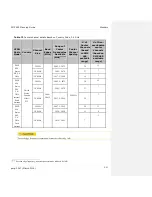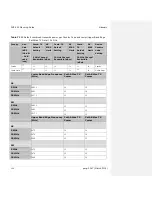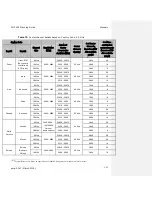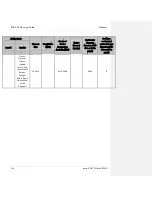
PMP 450 Planning Guide
Glossary
After an AP with DFS is powered on it performs a channel availability check on its main carrier frequency for 1
minute, monitoring for the radar signature without transmitting. If no radar signature is detected during this minute,
the module then proceeds to normal beacon transmit mode. If it does detect a radar signature, the frequency is
marked for a 30 minute non-occupancy period, and the module moves to its 1
st
alternate carrier frequency. The AP
continues this behavior through its 2nd alternate frequency if needed and then waits until the first frequency ends
the 30 minute non-occupancy period. While operating, if the AP detects a weather radar signature it marks the
current carrier frequency for a 30 minute non-occupancy period and moves to check the next-in-line carrier
frequency.
An SM does not begin transmission until it detects a beacon from an AP. If APs are not transmitting, SMs will be
silent.
Europe applies the ETSI specification to both APs and SMs, while Brazil applies it only to APs. In the ETSI case,
when an SM is powered on, it scans to find a Canopy beacon from a AP. If an AP is found, the SM performs a
channel availability check on that frequency for 1 minute, monitoring for the radar signature, without transmitting.
A DFS decision is made based on the following:
•
If no radar pulse is detected during this 1 minute, the SM proceeds through normal steps to register to an AP.
•
If the SM does detect radar, it locks out that frequency for 30 minutes and continues scanning other frequencies
in its scan list.
After an SM with DFS has seen a radar signature on a frequency and locked out that frequency, it may connect to a
different AP if color codes, AP transmitting frequencies, and SM scanned frequencies support that connection.
To simplify operation and ensure compliance, an SM takes on the DFS type of the AP to which it registers. For
example, when an SM in Europe registers to an AP with the Country Code set to “United Kingdom”, that SM will
use ETSI DFS, no matter what its Country Code is set to, even if its Country Code is set to “None”. Note, the
operator should still configure the Country Code in the SM correctly, as future releases may use the Country Code
for additional region-specific options.
For all modules running DFS, the module displays its DFS state on its Home => General Status page as one of the
following:
•
Checking Channel Availability Remaining time n seconds
,
where n counts down from 60 to
1.
•
Normal Transmit
•
Radar Detected Stop Transmitting for n minutes
,
where n counts down from 30 to 1.
•
Idle
, only for SM/BHS, indicates module is scanning, but has not detected a beacon from an AP/BHM. Once it detects
beacon, the SM/BHS begins a Channel Availability Check on that frequency.
pmp-0047 (March 2014)
3-35
Содержание PMP 450
Страница 1: ...Cambium PMP 450 Planning Guide System Release 13 1 ...
Страница 13: ...PMP 450 Planning Guide pmp 0047 March 2014 1 3 ...
Страница 30: ...PMP 450 Planning Guide Radio tab of the AP Figure 8 Radio tab of the AP 1 20 pmp 0047 March 2014 ...
Страница 41: ...PMP 450 Planning Guide Radio tab of the SM Figure 13 Radio tab of the SM pmp 0047 March 2014 1 31 ...
Страница 42: ...PMP 450 Planning Guide Figure 14 Custom Frequency tab of the SM 1 32 pmp 0047 March 2014 ...
Страница 58: ...PMP 450 Planning Guide Figure 16 AP web based management screenshot 1 48 pmp 0047 March 2014 ...
Страница 82: ...PMP 450 Planning Guide 1 72 pmp 0047 March 2014 ...
Страница 155: ...PMP 450 Planning Guide pmp 0047 March 2014 1 145 ...












































![Pentagram Cerberus [P 6367] Installation And Operation Manual preview](http://thumbs.mh-extra.com/thumbs/pentagram/cerberus-p-6367/cerberus-p-6367_installation-and-operation-manual_1524254-01.webp)



